During the process the pigment, a yellow slurry, was produced in vats of a varying sizes. These process vats were filled with the strong solution of iron sulphate made with the Copperas and were charged with the scrap steel. Air was bubbled through and the temperature was raised to 70 degrees C using hot water or steam.
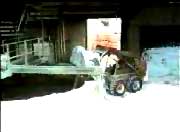
Iron + Air -> Iron Oxide solids (pigment) + Hydrogen gas
Iron oxide solids formed as needle-like crystals. In order to produce a clean bright yellow colour, the crystals needed to be all the same size. To make the crystals uniform some very fine iron oxide crystals were added to the vat when it was filled. They are called “seed” and were made in another part of the process. Scroll to end of page for more details on seed making.
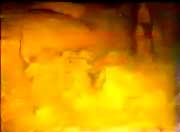
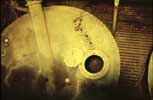
The mixture remained for around 4 days in the process vats. The vats were emptied when the required colour was attained.
The yellow slurry was now separated into iron oxide solids and the iron sulphate solution in which the product grew. This was done by filtering the product slurry in large multi-compartment, vertical pressure filters.
First the slurry was sieved to remove any debris washed out of the scrap steel. The slurry was heated to make filtration easier and was pumped into the filter. In the filter the product was partially compressed, washed, further compressed and dried. It was discharged from the press in cake form, but was still in fact 50% water.
Weaks The recovered liquid (or filtrate) was the original iron sulphate solution but diluted with the filter wash water. Therefore it was known as “weaks”. Most of it was reused in the factory to make "superstrong" and "strong" solutions and to make seed. Weaks surplus to requirements were processed, so that they could be returned to the river as clean water. Any settled solids left by the filtering process were sent way for landfill.
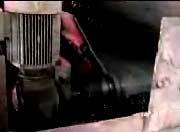
Yellow Pigment
Cake was passed through a tunnel drier. First it was fed into the drier extruder. The temperature in the drier had to be hot at the inlet end where the cake was wet, but cooler at the outlet end or the product could loose the small quantity of water which was tightly bound in it and kept it yellow in colour. The dried product then went to the mill to be ground to a fine yellow pigment powder and was packaged for sale.
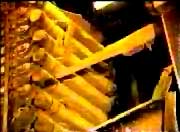

Yellow cake was taken to a higher temperature in a rotary kiln called a calciner. The kiln was a long inclined tube which rotated slowly causing the product to slowly tumble down through the kiln. At the lower discharge end was a gas or oil burner whose hot combustion gases passed up the kiln to meet the cake coming down. The hot gases leaving the kiln were quite dusty. They therefore passed through a high temperature fabric filter unit, so that discharge leaving the premises was dust-free.
The yellow cake tumbling down the inside of the kiln was first dried. The heat then removed the tightly bound water causing it to turn red. Finally the high temperature sintered the red making it deeper in colour. The kiln hot zone was between 650 and 950 degrees Celsius.
The calcined iron oxide was milled to a fine powder to improve the pigment strength and colour.
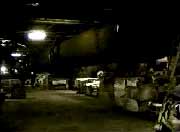

To make seeds weaks were passed through a pit of steel turnings. This iron pit process reduced the iron sulphate to the right state for seed making. A small addition of acid was made to activate the reaction. The treated weaks were pumped into large stirred tanks. Caustic was added to make the solution alkaline. All the iron sulphate was converted to iron hydroxide solids and no iron was left in the solution.
Iron sulphate solution + caustic (sodium hydroxide) > iron hydroxide solids + sodium sulphate solution.
Solids were allowed to settle leaving a clear top liquid. The liquid was then checked for impurities and processed before discharge to the river. The iron hydroxide solids remained. They were light blue in colour and were called "unchanged blues". To make iron hydroxide slurry into a yellow oxide seed it was first mixed with iron sulphate solution. Then air is bubbled through the mixture in an aeration vat.
iron hydroxide (unchanged blues) + air > iron oxide seed + water
The oxygen in the air converted the iron hydroxide solids into the very small uniform crystals of iron oxide seed needed for the process vats. As the reaction proceeded the colour of the mix changed from light blue to dark blue, to green and finally to a yellow khaki colour which was the seed.